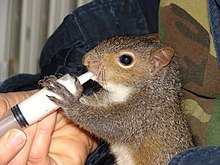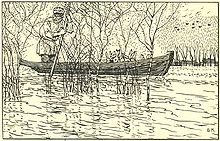Wildlife rehabilitation
This article needs additional citations for verification. (January 2019) |

Wildlife rehabilitation is the treatment and care of injured, orphaned, or sick wild animals so that they can be released back to the wild.
Process


Rehabilitation begins when an animal is found and reported to a wildlife rehabilitator, or seized from the illegal wildlife trade or a poacher. If you find wildlife in need of rescue, it can be dangerous or even illegal to interact with the animal yourself; be sure to contact a licensed rehabilitator before taking action.
The rehabilitator will examine the animal to determine the extent of the injury and the probability of successful rehabilitation. If it appears that the animal can make a sufficient recovery to be able to return to the wild, the animal will be fed, nurtured, provided safe temporary housing, and medically treated as necessary.
Animals that cannot be rehabilitated are usually euthanized humanely, although animals are occasionally placed at facilities appropriately licensed for educational exhibit or brought into appropriate lifetime care in a wildlife rescue center.
The goal of wildlife rehabilitation is to safely return the animal back to its home, but this is not always the case. A non-releasable animal may sometimes be kept by the rehabilitator (under separate permit) as a surrogate parent for orphaned or injured young wildlife.
Preventing imprinting and habituation is important in the rehabilitation process. Imprinting occurs when a young animal, specifically young birds, begin to see the rehabilitator as their primary caregiver.[1] It is possible to reverse this process in most animals, but it is permanent with birds. Rehabilitators have to take caution when caring for young animals in order to avoid this. It is critical to establish maintain boundaries between the rehabilitator and the animal. This includes wearing a mask and gloves around animals or even covering an animal's cage with a towel to prevent contact with humans.[2]
Background
The field of wildlife rehabilitation varies from small scale operations of individuals working from their homes, usually working with a veterinarian; to professionally staffed wildlife hospitals. Some organizations are teaching wildlife hospitals: Tristate Bird Rescue, Paws Wildlife Center, the Wildlife Center of Virginia, and The Clinic for Rehabilitation of Wildlife provide training to veterinary students from around the world, and offer one-year postdoctoral internships in clinical wildlife medicine. Other facilities are affiliated with universities, such as the Amos Rehabilitation Keep (ARK) at the University of Texas Marine Science Institute.
Another type of wildlife rehabilitator is the Senkwekwe Centre in Virunga National Park in the Democratic Republic of Congo, which cares for the only two orphan baby mountain gorillas in captivity. Their rescue and subsequent survival is considered an important contribution to the conservation of a critically endangered species.
Many wildlife rehabilitators and centers are also committed to improving the well-being of wildlife though public education; focusing on how humans can safely and peacefully coexist with native wildlife, and on wildlife's importance to humans and the environment. Wildlife rehabilitation clinics can also often offer advice and guidance on humane solutions for "nuisance" wildlife concerns.[3]
Legal issues
In many countries, including the United States and Australia, wildlife rehabilitation requires a license and/or permit. In these countries, it is against the law to rehabilitate (or in some cases possess) a wild animal without permits. In the United States, rehabilitation permits, requirements, and procedures for all animals other than birds vary from state to state.
Rehabilitation of birds in the U.S. requires, per the Migratory Bird Treaty Act, that a permit be obtained from both the state wildlife agency and the United States Fish and Wildlife Service. The only birds rehabilitators can admit without a federal permit are common birds considered to be introduced invasive species: rock doves, European starlings, and house sparrows; although some licensed rehabilitation facilities cannot accept introduced species as a condition of their licensing.[4]
There a number of regulations in place when it comes to wildlife rehabilitation. States require a license in order to work as a wildlife rehabilitator. In certain states, such as North Dakota, you must be a licensed veterinarian if you want to work in wildlife rehabilitation. Rehabbers must go through a lot of training before they obtain their wildlife rehabilitation license.[5]
Services provided by wildlife rehabilitators
- Lessens biologists workload.
- Ensure humane and professional care of injured animals.
- Provides great help to professional wildlife handlers to help WDFW with wildlife cope-up with emergencies.
- Provides data and staff-power for areas of wildlife research and retrospective studies.
- Specialized in threat and endangered species recovery.
- Assists in monitoring disease and domestic animal protection and public health.
- Provides self-regulation and self-enforcement within the wildlife rehabilitator community.
- Provides valuable public education and clear understanding regarding securement of wildlife community and its necessary motives.
See also
- Wildlife rehabilitation and conservation centers
- Among The Great Apes With Michelle Yeoh (documentary film about the Sepilok Orang Utan Sanctuary)
References
- ^ Edzenga, Lauren (2021). "The Dangers of Imprinting". Cedar Run Wildlife Refuge. Retrieved October 7, 2021.
- ^ Perry, Donna J (Fall 2020). "Caring for the circle of life: wildlife rehabilitation and sanctuary care". Human - Wildlife Interactions. 14: 309–324. ProQuest 2468395247 – via ProQuest.
- ^ For example, Wild Things Sanctuary: Living with Wildlife
- ^ "U.S. Fish & Wildlife Service - Migratory Bird Program | Conserving America's Birds". www.fws.gov. Retrieved 2021-10-10.
- ^ "Detailed Discussion of Wildlife Rehabilitation Laws | Animal Legal & Historical Center". www.animallaw.info. Retrieved 2021-10-09.
External links
This article's use of external links may not follow Wikipedia's policies or guidelines. (June 2020) |
Wildlife rescue organizations
- Philadelphia Metro Wildlife Center (Pennsylvania)
- Orphaned Wildlife Rescue Center-Maryland
- National Wildlife Rehabilitators Association
- International Wildlife Rehabilitation Council
- British Wildlife Rehabilitation Council
- Suncoast Seabird Sanctuary (Florida)
- St. Tiggywinkles
- Tri-State Bird Rescue (Delaware)
- California Council for Wildlife Rehabilitators
- Lindsay Wildlife Museum and Wildlife Hospital, Walnut Creek (N. California)
- Wildlife Rehabilitation Center of Minnesota
- PAWS Wildlife Center (Washington)
- C.R.O.W. Wildlife Clinic
- Center for Animal Rehabilitation and Education, South Africa
- Carolina Raptor Center (North Carolina)
- Wild Things Sanctuary (New York)
- Animal Advocates Wildlife Rehabilitation
- Second Chance Wildlife Center (Maryland)
- Wildlife Center of Virginia
- Free Again Wildlife Rehabilitation (Illinois)
- Blue Ridge Wildlife Center (Virginia)
- WildCare BayArea, San Rafael (N. California)
- Valley Forge Native Wildlife Refuge (Scotland)
- Directory of British Wildlife Rehabilitators
- Directory of Australian Wildlife Rehabilitation Associations
- Volunteer South Africa Endangered Wildlife Rehabilitation and Breeding Centre
- Red Creek Wildlife Center, Inc. (Pennsylvania)
- Wildlife Rescue Association of B.C.
- Genesis Zoological and Wildlife Rescue (Florida)
- Wild Baby Rescue Center (New Jersey)
- Wildlife Rapid Rescue Team - Wildlife Alliance Archived 2015-07-02 at the Wayback Machine
- Ohio Wildlife Rehabilitators Association
- Vermont Institute of Natural Science
- Florida Wildlife Hospital & Sanctuary
- Center for Wildlife (Maine)
- Sacred Friends Inc (Virginia)
- Scottish Society for the Prevention of Cruelty to Animals (SSPCA) National Wildlife Rescue Centre (Scotland)
- Wolf Hollow Wildlife Rehabilitation Center (Washington)
- AWARE Wildlife Center (Georgia)
- WILDNorth Wildlife Rescue and Rehabilitation (Alberta, Canada)
- Alberta Institute for Wildlife Conservation (Alberta, Canada)
- Calgary Wildlife (Alberta, Canada)
Information
- Publication for the public when they find wildlife in distress
- I Found An Animal
- Rescuing Wildlife - A Guide to Helping Injured and Orphaned Animals
- Wildlife Rehabilitation Manual
- Rehabilitation of baby ground squirrels
- Rehabilitation of baby tree squirrels
- Rehabilitation of baby striped skunks
- USFWS Migratory Bird Permits
